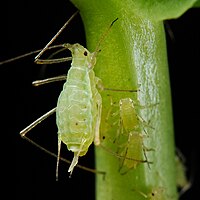
Photo from wikipedia
Abstract Comparative studies of genetic diversity and population structure can shed light on the ecological and evolutionary factors governing host–parasite interactions. Even though invasive parasites are considered of major biological… Click to show full abstract
Abstract Comparative studies of genetic diversity and population structure can shed light on the ecological and evolutionary factors governing host–parasite interactions. Even though invasive parasites are considered of major biological importance, little is known about their adaptative potential when infesting the new hosts. Here, the genetic diversification of Varroa destructor, a novel parasite of Apis mellifera originating from Asia, was investigated using population genetics to determine how the genetic structure of the parasite changed in distinct European populations of its new host. To do so, mites infesting two categories of hosts in four European regions were compared: (a) adapted hosts surviving through means of natural selection, thereby expected to impose strong selective pressure on the mites, and (b) treated host populations, surviving mite infestations because acaricides are applied, therefore characterized by a relaxed selection imposed by the host on the mites. Significant genetic divergence was found across regions, partially reflecting the invasion pattern of V. destructor throughout Europe and indicating local adaptation of the mite to the host populations. Additionally, varying degrees of genotypic changes were found between mites from adapted and treated colonies. Altogether, these results indicate that V. destructor managed to overcome the genetic bottlenecks following its introduction in Europe and that host‐mediated selection fostered changes in the genetic structure of this mite at diverse geographic scales. These findings highlight the potential of parasites to adapt to their local host populations and confirm that adaptations developed within coevolutionary dynamics are a major determinant of population genetic changes.
Journal Title: Ecology and Evolution
Year Published: 2021
Link to full text (if available)
Share on Social Media: Sign Up to like & get
recommendations!